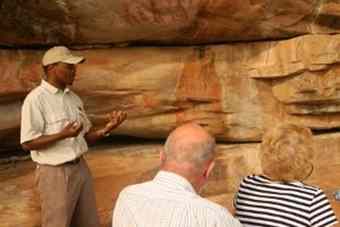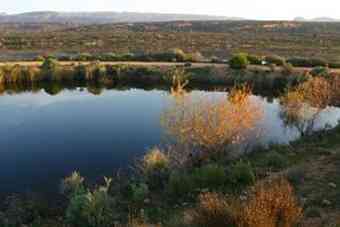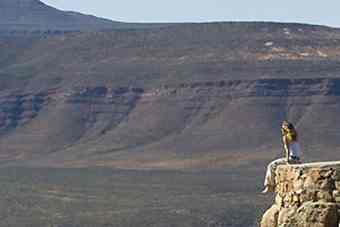Everyone stands silent and in awe, gazing ahead in bemused wonder. Some are so enthralled they don’t even notice the herd of mountain zebra watching them from behind. And as rock art archaeologist Siyakha Mguni unravels the story painted on the rock overhang, mouths literally drop open in wonder. The Cederberg is a massive outdoor rock canvas where hundreds of Bushman rock art sites have been discovered, and new ones are still being found.
 Cave Bee, White Net, Elephant Roof and Bleeding Nose are all curious names for rock art sites, but Charlie Brown has to be the quirkiest.
Cave Bee, White Net, Elephant Roof and Bleeding Nose are all curious names for rock art sites, but Charlie Brown has to be the quirkiest.
“It’s a special site because it’s one of the few known sites depicting women’s ritual activities, and is likely to have been painted by the women themselves. And it’s also a great example of the pinched knee painting technique in the legs of the figures,” says Mguni, one of just a handful of specialized rock art archaeologists in the world, resident at Bushmans Kloof Wilderness Reserve
“The Bushman had many painting techniques, but this one is an extreme example because the knees are now represented by gaps, that were initially white pigment and beads. The exaggerated calf muscles are also unusual for paintings of women.”
Wavy lines across the painting also are widely thought to depict visions while in trance. And its thought this is why the site has its comic name, as they look a little like the design on the cartoon character”s shirt.
What has really caused jaws to drop is that all the 130 plus rock art sites on the reserve are painted using natural materials from the area - and many are over 10 000 years old, predating both the birth of Christ and possibly the construction of the pyramids. This art is so ancient, merely viewing it is comparable to a spiritual experience. Importantly, Bushman rock art gives insight into the minds and spirituality of these nimble people, whereas most archaeological finds unearth artefacts that only tell what ancient peoples did.
Today the Cederberg is viewed through different, modern eyes with satisfied appetites. It’s a breathtakingly beautiful rockscape of towering pinnacles and deep caves, and if you look carefully animal and bird figures will reveal themselves to you in the orange sandstone of the area.
The rock sculptures here are truly ancient, dating to between 500 and 345 million years old, and in some areas there are even marine fossils. First time visitors to the area come to see the Wolfberg Cracks and Arch, the Maltese Cross and Stadsaal Caves. Others want to hike the trails like the 4km self-guided Sevilla Trail through 10 rock art sites, explore the area on quad bikes or camp out in a true wilderness under a ceiling of stars.
There’s more than Bushman history in the area too. Just off the main road traversing the Cederberg is a smallish rock, that when viewed from the right angle, is unmistakably a soldier’s head – Soldaatkop - staring into the rooibos that grows naturally there.
"In spring the area comes alive"
And not far away is the grave of a fallen soldier, killed in battle in the area in 1901. With the headstone cross inscribed “Brave and True”, this is the resting place of one Graham Vinicombe Winchester Clowes. Legend tells that his grief-stricken mother travelled from Hertfordshire in England to Cape Town and then deep into the Cederberg every year to lay a wreath on his grave on the anniversary of his death. That before the advent of air travel.
 Named after the cedar trees that were once prolific in the area, mountain fynbos now covers the Cederberg. In spring the area comes alive with colourful pincushions, lilies, daisies and more - especially in the Biedouw valley. However constant alien plant eradication is necessary to keep the over 755 indigenous plant species healthy and prolific.
Named after the cedar trees that were once prolific in the area, mountain fynbos now covers the Cederberg. In spring the area comes alive with colourful pincushions, lilies, daisies and more - especially in the Biedouw valley. However constant alien plant eradication is necessary to keep the over 755 indigenous plant species healthy and prolific.
Indigenous fauna is also an appealing attraction with grey rhebuck, klipspringer, dassies and baboons frequently seen. The elusive Cape leopard also lives in the mountains - though is rarely spotted - and endangered mountain zebra live in the Bushmans Kloof section. Birdlife is enticing too and everything from raptors to sunbirds and sugarbirds live here.
So do ghosts. The ghost of Oupoort is said to have created an unseen impassable barrier in the mountains, as in the old days no horse - and hence no human - would enter the pass after dark. Modern reports tell of an attractive lady hitchhiker who caused drivers to crash their cars when her fine hair blew across their faces at a dangerous bend in the road. Others say she caught a ride by jumping onto the vehicle’s running boards, but almost always her fine hair blinded the driver and caused accidents. Believe it or not.
Resting place of C Louis Leipoldt
Literary legend C Louis Leipoldt truly loved the Cederberg and all that lived in it. He’s renowned for his poetry and writing drama and travel books - he also wrote detective novels and cookery books - but he was also a botanical explorer and several plants are named after him. His grave lies just 17km from Clanwilliam in the Pakhuis Pass of his beloved Cederberg, overlooking the peaks Faith, Hope and Charity that he fondly named.
 Descending the Cederberg through the aptly named Pakhuis Pass, which looks like a warehouse of neatly packed sandstone blocks, you’ll discover is Clanwilliam - entrance and exit to the Cederberg. Embraced by the Olifants and Jan Dissels rivers, the little town is one of the oldest in South Africa and is set against a mighty mountain backdrop where buchu grows wild.
Descending the Cederberg through the aptly named Pakhuis Pass, which looks like a warehouse of neatly packed sandstone blocks, you’ll discover is Clanwilliam - entrance and exit to the Cederberg. Embraced by the Olifants and Jan Dissels rivers, the little town is one of the oldest in South Africa and is set against a mighty mountain backdrop where buchu grows wild.
Clanwilliam is the only place on earth where rooibos tea can be cultivated, but there are plenty of vineyards and citrus trees too plus endangered fynbos species. This is also the home of “veldskoens” which can come in useful when traipsing through the spring daisies in August and September.
Then the whole area is a riot of dancing daisies and the Ramskop Nature Reserve alone - near the Clanwilliam Dam resort - has over 250 indigenous wild flower species to see, right there. Or you could do a heritage trail through the town to marvel at historical buildings and soak up the old world flavour of the area.
Wherever you venture in the Cederberg, there’s an underlying stillness. The antiquity is palpable, in the dramatic rocks and unusual vegetation, and that ancient time is lamented in the intricate paintings of the Bushmen. They lived off the land, treated it with respect and took only what they needed.
Siyakha Mguni believes it may be their great lesson to us: “They didn’t even leave footprints. But they did leave a legacy and an open air gallery cast in stone.”
One we are only just starting to understand and truly appreciate.
Author: Keri Harvey | Source: iafrica {July 19, 2010]